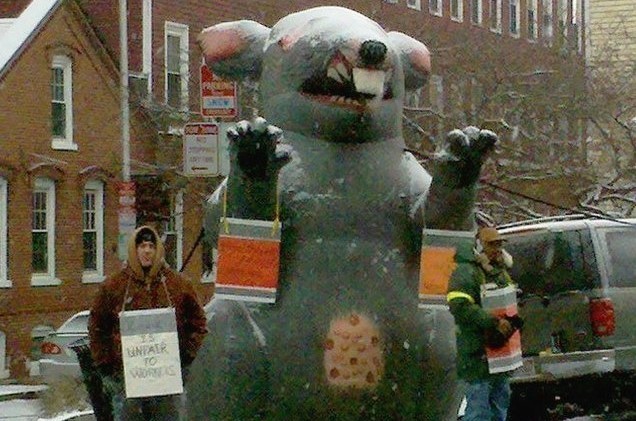 News
NewsThe US National Labor Relations Board (NLRB) on Wednesday ruled that an Indiana labor union group (“the Union”) did not violate the National Labor Relations Act (“the Act”) with its display of a 12-foot inflatable rat with red eyes, fangs, and claws (“Scabby the Rat”) and two large banners to boycott a business near the public entrance to a trade show.
The former general counsel for the NLRB, Peter Robb, filed a complaint alleging that the display of these items “was unlawfully coercive” arguing that the Board should overrule precedent. The Board relied on precedent that dealt with similar complaints and dismissed the complaint in a 3-1 decision after ruling that displaying banners or an inflatable rat near the entrance of a neutral employer, without more, does not “threaten, coerce, or restrain.”
In a separate concurrence, Board members Marvin Kaplan and John Ring, while agreeing with precedent, expressed discomfort at the Union’s targeting of what is considered neutral parties to its boycott. Kaplan and Ring pointed out that while the Union’s labor dispute was with MacAllister Machinery, its banner display targeted Lippert Components—a company that did business with MacAllister and the party that filed the complaint. Furthermore, Kaplan and Ring noted that the Union displayed Scabby the Rat and two other stationary banners measuring 8 by 3.75 feet near the entrance to a trade show hosted by Thor Industries, an RV manufacturer.
Aside from the fact that Lippert supplied components to Thor’s RVs, Kaplan and Ring noted that Thor did not even have a tangential connection to the dispute. Stating that Congress enacted § 8(b)(4) of the Act to protect neutral parties from being dragged into labor disputes, Kaplan and Ring agreed with the dissent’s view that “the Board must remain committed to the vigorous enforcement of this prohibition, which is vital to achieving one of the Act’s chief goals: safeguarding commerce from disruptions.”
In any event, acknowledging that Supreme Court precedent requires the Board to respect First Amendment rights, Kaplan and Ring concurred that the complaint must be dismissed to avoid applying § 8(b)(4) of the Act “in a way that raises questions regarding the constitutionality of that statutory provision.”
Chairman of the Board, Lauren McFerran, also concurred, aiming at the “dissent’s central flaw” in calling for the restriction of the Union’s activities. According to McFerran, dissenting board Member William Emanuel contended that “non-speech intimidation predominates over any expressive element—resulting in diminished constitutional protection for, and legitimate restriction of, the Union’s activities.”
Stating that this is simply contrary to overwhelming Supreme Court precedent protecting a wide range of expressive activity including offensive speech, McFerran noted her consensus with Kaplan and Ring that “under the constitutional avoidance doctrine, the potential infringement of a union’s First Amendment rights precludes the Board from finding that the banners and inflatable rat in these circumstances violate § 8(b)(4)(ii)(B).”

